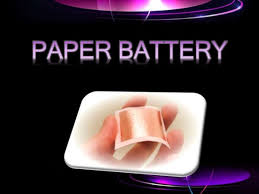
SEMINAR ON
Paper battery
A paper battery is engineered to use a spacer formed largely of cellulose (the major constituent of paper). It incorporates nanoscopic scale structures to act as high surface-area electrodes to improve conductivity.
In addition to being unusually thin, paper batteries are flexible and environmentally friendly, allowing integration into a wide range of products. Their functioning is similar to conventional chemical batteries because they are non-corrosive and do not require extensive housing.
Advantages[edit]
The composition of these batteries is what sets them apart from traditional batteries. Paper is abundant and self-sustaining, which makes paper cheap. Disposing of paper is also inexpensive since the paper is combustible as well as biodegradable. Using paper gives the battery a great degree of flexibility. The battery can be bent or wrapped around objects instead of requiring a fixed casing. Also, being a thin, flat sheet, the paper battery can easily fit into tight places, reducing the size and weight of the device it powers. The use of paper increases the electron flow which is well-suited for high-performance applications. Paper allows for capillary action so fluids in batteries, such as electrolytes, can be moved without the use of an external pump. Using paper in batteries increases the surface area that can be used to integrate reagents. The paper used in paper batteries can be supplemented to improve its performance characteristics. Patterning techniques such as photolithography, wax printing, and laser micromachining are used to create hydrophobic and hydrophilic sections on the paper to create a pathway to direct the capillary action of the fluids used in batteries. Similar techniques can create electrical pathways on paper to create paper electrical devices and integrate paper energy storage.[3]
1. Used as both battery and capacitor.
2. It is flexible.
.It is an ultra-thin energy storage device.
4. Long lasting.
5. Nontoxic.
6. Steady power production.
7. biodegradable 8.no leaking and overheating
Disadvantages[edit]
Although the advantages of paper batteries are quite impressive, many of the components that make them great, such as carbon nanotubes and patterning, are complicated and expensive.[3]
1. Prone to tearing.
2. Nanotubes made from carbon are expensive due to the use of procedures like electrolysis and laser ablation.
3. Should not be inhaled, as they can damage the lungs.
Electrolytes[edit]
This cellulose-based spacer is compatible with many possible electrolytes. Researchers used ionic liquid, essentially a liquid salt, as the battery’s electrolyte, as well as naturally occurring electrolytes such as human sweat, blood, and urine. The use of an ionic liquid, containing no water, would mean that the batteries would not freeze or evaporate, potentially allowing operation in extreme temperatures.[citation needed] The operating conditions (e.g. temperature, humidity, static pressure) of such batteries would depend on the physical and chemical properties of the electrolyte, as well as the durability of the cellulose mesh; both potentially limiting factors.
Potential applications[edit]
The paper-like quality of the battery combined with the structure of the nanotubes embedded within gives them lightweight and low cost, offering the potential for portable electronics, aircraft, automobiles, and toys (such as model aircraft).
The batteries employ nanotubes, potentially slowing commercial adoption due to excessive cost. Commercial adoption also requires larger devices. E.g., a newspaper-sized device could be powerful enough to power a car.[4]
Paper can be integrated into several different forms of batteries, such as electrochemical batteries, biofuel cells, lithium-ion batteries, supercapacitors, and nanogenerators.
Electrochemical batteries[edit]
Electrochemical batteries can be modified to integrate the use of paper. An electrochemical battery typically uses two metals, separated into two chambers and connected by a bridge or a membrane which permits the exchange of electrons between the two metals, thereby producing energy. Paper can be integrated into electrochemical batteries by depositing the electrode onto the paper and by using paper to contain the fluid used to activate the battery. Paper that has been patterned can also be used in electrochemical batteries. This is done to make the battery more compatible with paper electronics. These batteries produce low voltage and operate for short periods, but they can be connected in series to increase their output and capacity. Paper batteries of this type can be activated with bodily fluids, making them very useful in the healthcare field, such as single-use medical devices or tests for specific diseases.[3] A battery of this type has been developed with a longer life for PowerPoint point of care devices for the healthcare industry. The device used a paper battery made using a magnesium foil anode and a silver cathode and has been used to detect diseases in patients such as kidney cancer, liver cancer, and osteoblastic bone cancer. The paper was patterned using wax printing and can be easily disposed of. Furthermore, this battery was developed at a low cost and has other practical application
Date and time





